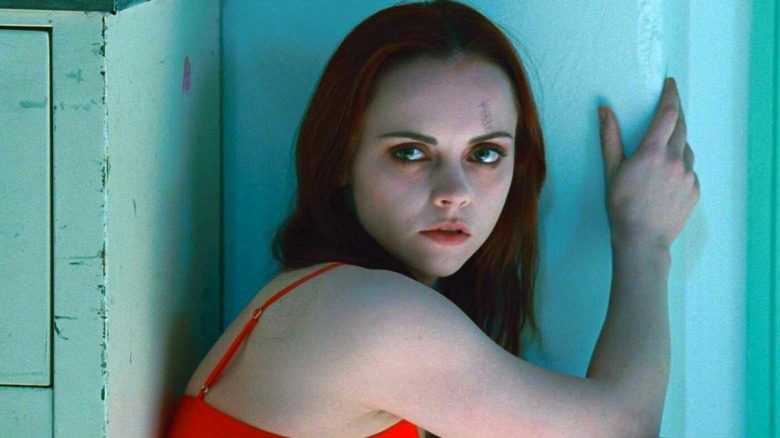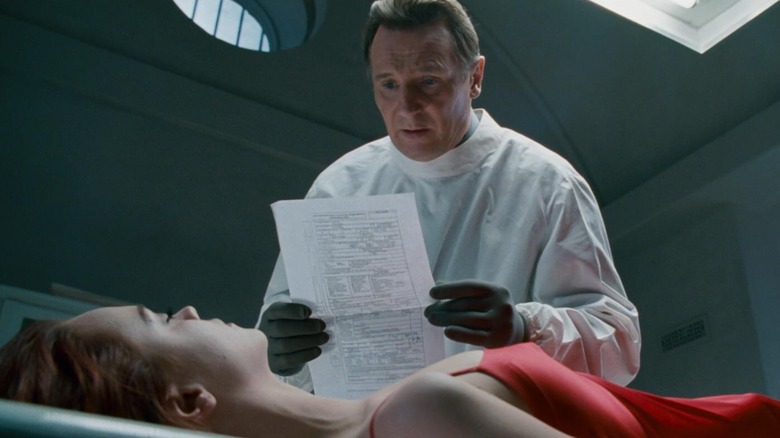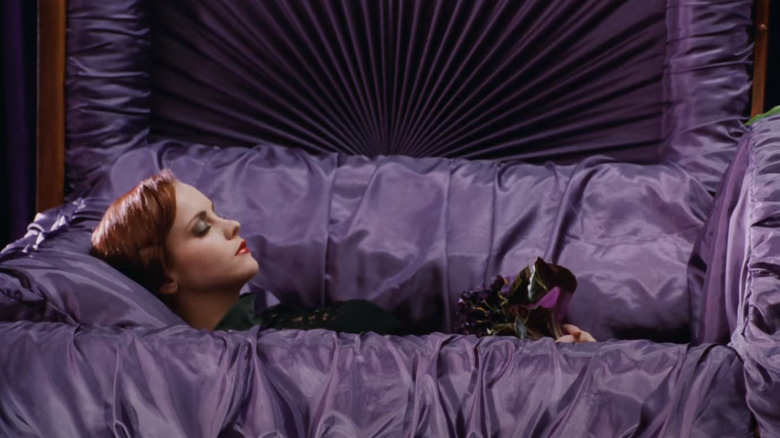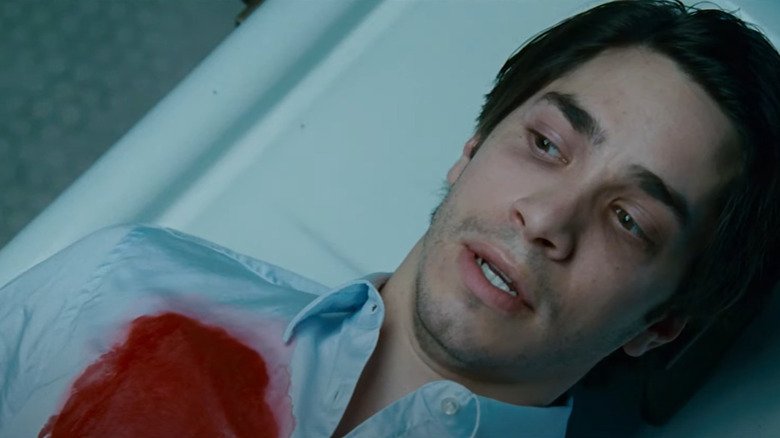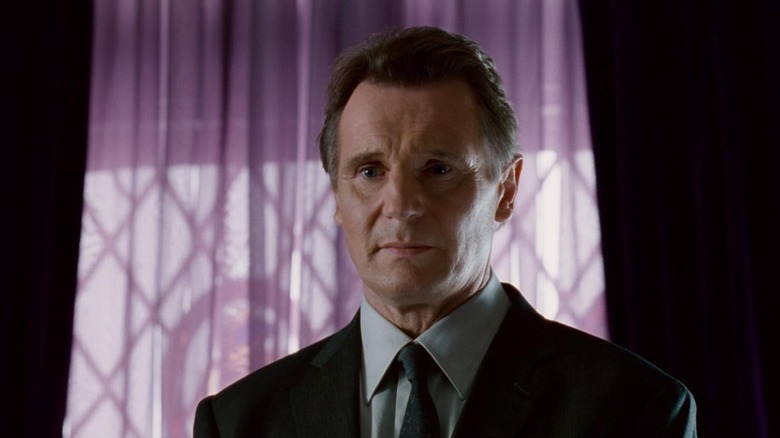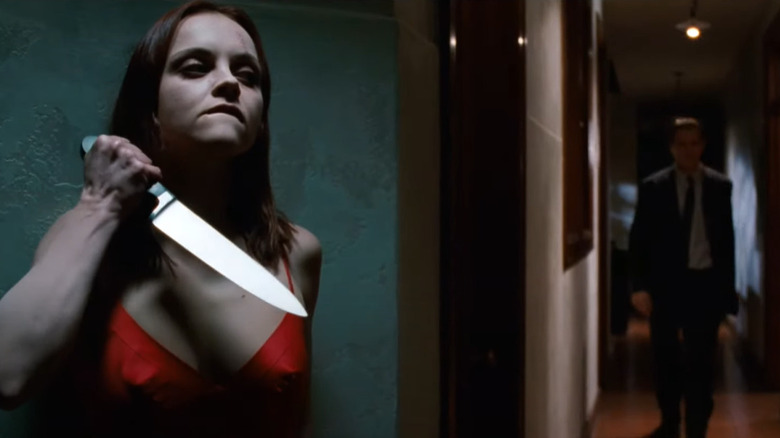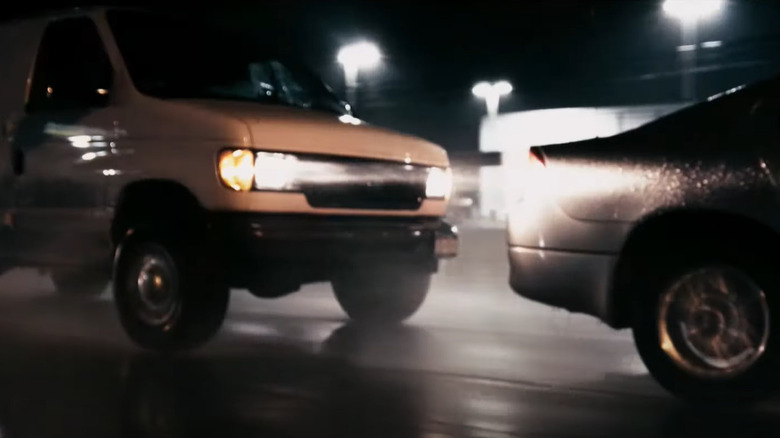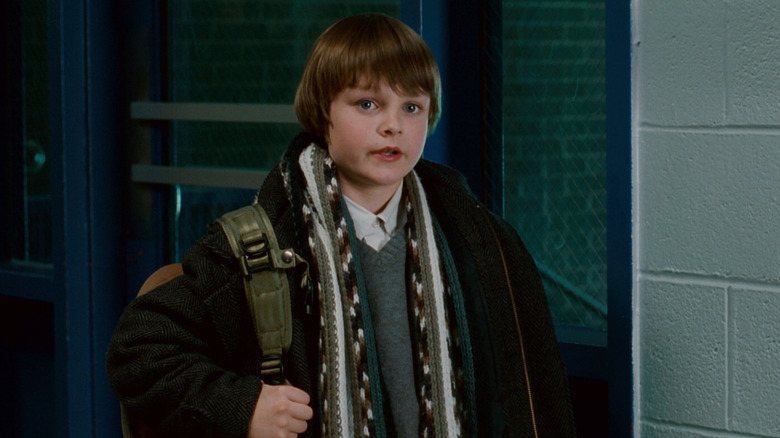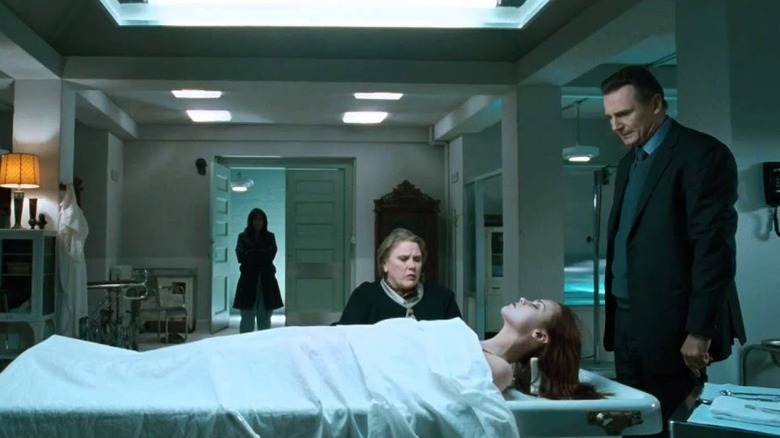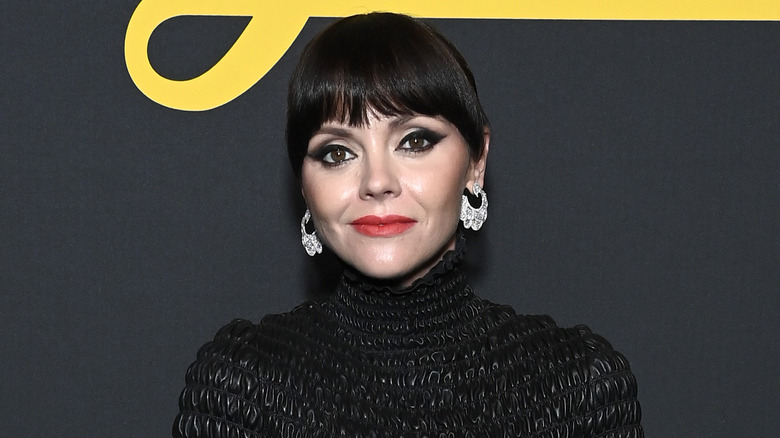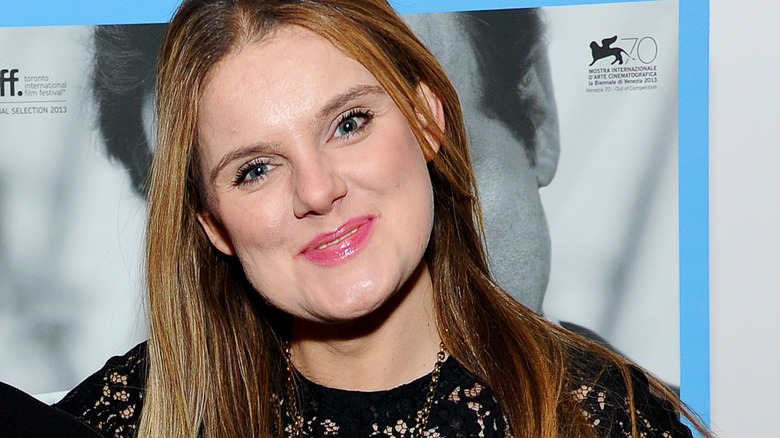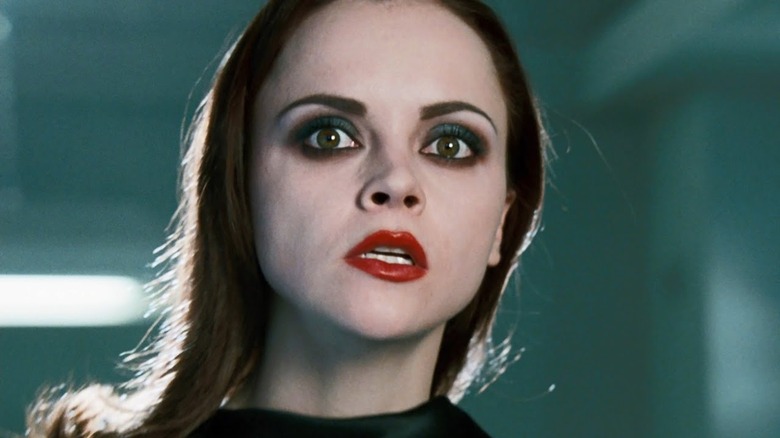The Ending Of After.Life Explained
Even though he'd been in the business for over 30 years prior to this, 2009's "After.Life" marked only the second time Liam Neeson appeared in a horror movie, with the first being "The Haunting" in 1999. Both films cover a similar concept — what awaits us after death — but with decidedly different approaches. Alongside Neeson in "After.Life" are Christina Ricci and Justin Long, playing a couple whose relationship is marred by tragedy.
With a premise that still feels fresh over a decade after its release, "After.Life" is something of a forgotten horror flick nowadays, and that's a real shame. With twists and turns at nearly every moment, and with two conflicting answers to what we're seeing on screen, it's a movie that remains confusing to even some of the most seasoned horror fanatics. We'll be covering exactly what happened at the ending, exploring the deeper themes behind the film, and seeing what the film's cast and crew have said about "After.Life" since its release.
What you need to remember about the plot of After.Life
"After.Life" begins with middle school teacher Anna (Christina Ricci) attending the funeral of her former piano teacher, where she meets the funeral's director Eliot Deacon (Liam Neeson). That night, her relationship with her boyfriend and hopeful fiancé Paul (Justin Long) is shown to be in shambles, as the two argue over dinner before she speeds off into the rainy night. Early the next morning she wakes up on an embalming table and once again comes face to face with Eliot, who shockingly informs Anna that she was pronounced dead the night before. He states that to most people, Anna appears to be a lifeless corpse, but unlike the rest of them, he has the rare gift of being able to communicate with the dead.
Understandably taken aback by his claims, Anna spends much of the film in denial about her death, even going so far as to repeatedly try and escape the funeral home. Meanwhile, her boyfriend Paul refuses to accept the reality of the situation and goes looking for the truth. However, things aren't as simple as they seem, because, for every new piece of evidence that suggests Anna has passed away, there seems to be another giving hope she may still be alive. It all culminates in a frantic ending with a handful of twists, and more than a few questions begging to be answered.
What happened at the end of After.Life?
Throughout "After.Life," we're forced to ask ourselves the question of whether or not Eliot is telling her the truth and if Anna really is dead. The psychological battle between the two serves as the crux of the film, with Eliot eventually convincing her to accept her own death. But in their final interaction, as Anna is fully prepared both physically and mentally for her funeral, she asks Eliot to let her see herself one final time. It's then, in the reflection of a small handheld mirror, that she notices her own breath condensing on the glass. In a final grim realization, she learns that Eliot has been lying to her the whole time, moments before he injects her with a powerful sedative.
The film doesn't end there, however, as in the aftermath of her burial we're shown a final confrontation between Paul and Eliot. It's then that Eliot reveals to Paul that perhaps Anna never was truly dead, leading him to drunkenly drive to the graveyard and exhume her body. Meanwhile, we watch as Anna wakes up in her coffin, and begins to desperately try and claw her way to freedom before finally being rescued at the last moment by Paul. But we're still left with a lingering question: did all of that really happen?
What the ending of After.Life means
As viewers will remember, once Paul finally pulls Anna from her casket, their loving embrace is broken by Eliot and Jack's (Chandler Canterbury) arrival. In the next scene, we watch as Paul wakes up on the same embalming table Anna found herself on just days earlier, with the mortician and his new assistant standing over him. As he gives Paul the familiar spiel, telling him that he died in a car accident and never actually made it to the cemetery, Paul predictably protests, shouting that he's still alive. But instead of trying to convince him of his death, Eliot slowly stabs Paul with a medical tool while Jack looks on.
When the credits begin to roll, we're left to decide which of the two narratives to believe. Was Eliot being truthful throughout the events of the film, with both he and perhaps even Jack given a rare ability to communicate with the deceased and help them transition to whatever lies beyond? Or was he instead lying to Anna and Paul the entire time, and actually the mastermind behind a far more sinister scheme?
Could Eliot actually speak to the dead?
As Anna — and at times the audience — are led to believe, Eliot is supposedly something of a medium, who claims to be able to speak with the dead and help them move on in the limited time they have left. This makes him a character not unlike the Grim Reaper, who is not a malicious villain but instead more a force of nature, with a solemn duty to make the departed the harsh reality of their fate. After all, it's not just Anna that Eliot can apparently speak to. When the brother of police officer Vincent Miller (Shuler Hensley) arrives in the home, Eliot is shown having a conversation with the dead man, even if he's never actually shown to be speaking. Additionally, he seems to have the ability to speak to the deceased even after they've left the property, by way of a photo collage he maintains of every body he's prepared.
If this theory is true, it would also mean that Anna really did die in the car accident, which would explain things such as her lingering presence being felt in Paul's apartment, as well as the distorted nature of the phone call to him she placed from the funeral home. As Eliot states, her refusal to accept her own death has manifested as a ghostly presence in Paul's life, making it even harder for him to move on. Unfortunately, it may not be that simple, and the true nature of Eliot may be far less paranormal, but no less disturbing.
What if Anna was alive the whole time?
Though Eliot spends much of his time trying to convince Anna of her own demise, some of the film's most compelling pieces of evidence point to the contrary. Beyond just her own breath in the mirror, which Eliot is shown trying to hide from her in an earlier scene, the fact that Anna is the only body in the basement that we actually see him have a conversation with suggests not everything is as it seems. Additionally, Eliot's efforts to keep her locked in the funeral parlor's basement in a particularly tense scene are suspicious, especially when one connects the dots on the supposed muscle relaxant he has been using on her.
From her very first appearance as a "corpse," Anna is repeatedly injected with a drug called hydronium bromide just before anyone besides Eliot is going to be around her. The first time was when her mother visited, then a police officer, and finally, at her own funeral. In a separate scene, as Paul pleads with police to try and obtain a search warrant for Eliot's funeral home, one of the officers mentions that the same chemical Eliot is using is capable of significantly dropping a victim's heart rate and even paralyzing them. All this points to a more upsetting truth that contradicts Eliot's presentation of himself as a tortured soul.
Is Eliot actually the villain?
Given that there's an argument to be made for Anna being alive the whole time, it's not a stretch to consider the fact that Eliot is not just a mortician, but a deranged serial killer as well. Eagle-eyed viewers may have noticed that the car that drove Anna off the road at the beginning of the film was a white-paneled van identical to the one Eliot is seen driving later on. With that in mind, as well as Eliot drugging Anna to keep her in the funeral home, it seems likely that he was responsible for her car accident, where he injected her with the substance to fool paramedics who would promptly deliver Anna's body to him.
Going a step further, if Eliot is in fact a mortician who moonlights as a serial killer, it's unlikely that Anna is his first victim. It's a theory that the film's director, Agnieszka Wojtowicz-Vosloo is on board with. In a brief interview seen on the DVD version of the film, she opens up about what Eliot's photographs of the dead really meant: "When you look at the wall in the final scene ... there are people that have closed eyes, and there are people who have open eyes ... My thinking behind it is that the people that had open eyes are the ones that actually were physically alive that got buried alive, and the ones that actually had closed eyes are the ones that were actually dead."
What was going on with Jack?
Introduced to us before Anna's supposed death, Jack is one of the students at the middle school she used to work at. And while he seems to be just another normal kid at first, it soon becomes clear he's anything but. The first piece of what becomes a pattern of disturbing behavior is when he believes a dying baby chick in his classroom to already be dead, despite clear signs of life. Later, and after Anna's accident, he starts hanging around the funeral home at all hours of the day, when he spots a "dead" Anna staring at herself in the mirror one night. Not long after, Eliot opens up to the boy about his own special gift and tells Jack that they may both possess this supernatural power.
Of course, if the more logical of the two arguments is to be believed, then we are watching Eliot not just manipulate Anna, but also a young boy to become something of his successor. Towards the end of the film, we watch as Jack buries the chick, still alive, mirroring Anna's fate. In the closing scene, his transformation into Eliot's assistant has been completed, with the two sedating the still-alive Paul, only to kill him as Eliot has done countless times before.
What does it mean to truly be alive?
While we've already discussed at length whether or not Eliot was the film's villain, what we haven't discussed are his motives. Given that much of the film is set in one room, dominated by dialogue between Anna and Eliot, we're given a clear glimpse into the mind of Neeson's character, and have enough clues to understand why — if he is a murderer — he continues his killings.
Unlike lesser horror movie villains, Eliot is given a pretty clear rationale for his actions — as deranged as they may seem. From Eliot's perspective, there is little difference between those who live a life without purpose and those who are truly dead. Therefore, in his mind, it is only appropriate to bury them all. As Anna's funeral approaches, he seems to offer her a way out, swinging open the door to the room she's been locked in and offering her a chance to go through it. But after Anna comes face to face with horrifying visions of her own burial, she backs down from the opportunity, effectively proving to Eliot that she isn't worthy of life if she won't fight for it.
Later, while growing closer to Jack, Eliot further sums up why he kills, telling the boy that Anna must be buried not because she is dead, but "because there is no more life left in her." Even if one of his victims is still breathing is trivial to Eliot, as he views someone having a purpose as being the only true quantifier of life.
What has Christina Ricci said about the film?
Shortly before its release, Christina Ricci appeared in an interview with the Los Angeles Times, where she opened up on everything from her own feelings on the film, to some of the more technical challenges behind the scenes. Unsurprisingly, long hours of shooting that involved her lying on the embalming table proved less than comfortable for the actress. "My spine and the back of my hips got bruised on the first day" she stated, adding, "The doctor came and he said, 'All I can do is give you painkillers.' The crew tried to warm the table for me. Someone brought in an electric blanket ... But it was November and we were in a poorly insulated warehouse in New York City. I got sick."
Despite the physical challenges, the project seemed to be well worth the effort for Ricci, who became engrossed in a story she described as "much more like a character piece" as opposed to a horror film. "I kind of missed the scariness of it because I was sort of taken in by this question of death and if you have feelings after you're dead. If I woke up tomorrow dead, how would I feel? That's what I talked to Agnieszka [Wojtowicz-Vosloo] about when I first met her."
What has director Agnieszka Wojtowicz-Vosloo said about the film?
In an interview for the DVD extras for the film, director Agnieszka Wojtowicz-Vosloo opened up regarding the ending of the film and provided a little insight into her motivations behind the project: "I had this image of a young woman lying on a slab in a mortician's funeral home, in the prep room. And you see this very calm, meticulous mortician preparing her body and suddenly she opens her eyes and she says 'Where am I?' and he calmly says 'You are dead.' That little kernel of an idea sparked this whole script."
She went on to explain a religious belief about what happens during and after death that also inspired the more technical details of the story, saying: "I was always fascinated by this Buddhist approach, where people believe that there's this transitional period of three days, and you're not supposed to disrupt the body you're supposed to kind of leave it alone because that's where the transition begins to happen. That's something that I used for 'After.Life' as the basis of the story."
What have critics said about After.Life?
Of course, the cast and creator of the film weren't the only ones to weigh in on "After.Life" upon release. Given its notable cast, a film that otherwise may have been doomed to obscurity attracted plenty of attention from both critics and audiences, not all of which was positive. Though most critics commended the film's unique premise, such as Rene Rodriguez of the Miami Herald who called it "admittedly compelling," they mostly found the film dull, with Rodriguez later saying that the film's director "just needs to learn how to entertain an audience — or at least come up with a film that doesn't try so hard to be profound yet has absolutely nothing to say about the way the living deal with death."
Renowned critic Roger Ebert went into great detail about why he thought the ending just didn't work, stating: "I think, in a way, the film short-changes itself by not coming down on one side or the other. As it stands, it's a framework for horror situations but cannot be anything deeper. Yes, we can debate it endlessly — but pointlessly, because there is no solution. We can enjoy the suspense of the opening scenes, and some of the drama. The performances are in keeping with the material. But toward the end, when we realize that the entire reality of the film is problematical, there is a certain impatience."
